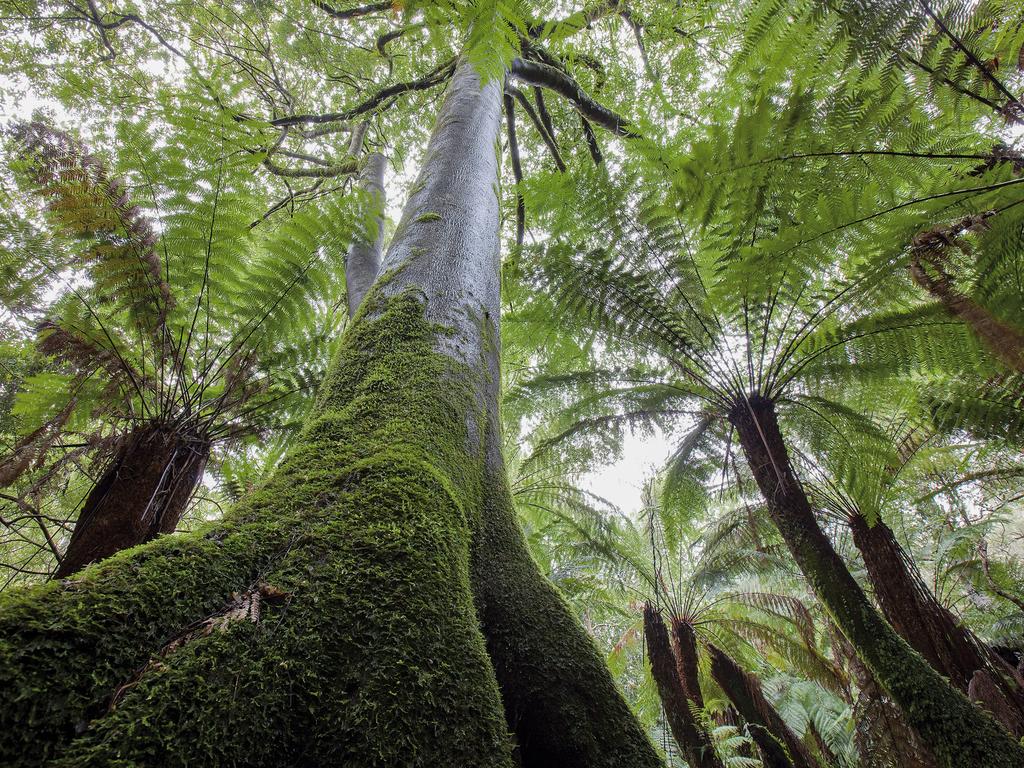Election shock: Liberals’ logging expansion risks reigniting forest wars
Tasmania’s Liberal Premier is vowing to boost timber supply by logging 40,000ha of protected native forests, wedging Labor for the March 23 state election.

Tasmania’s Liberal Premier is vowing to boost timber supply by logging 40,000ha of native forests protected under the 2012 forestry peace deal, reigniting the state’s “forest wars” and wedging Labor.
Jeremy Rockliff’s bold decision, to be announced on Thursday, boosts supply for sawmillers and allows Tasmania to capitalise on the phase-out of native forest logging by Labor governments in Victoria and WA.
However, it is almost certain to spark market campaigns against Tasmania’s timber industry and a level of protest not seen on the island for more than a decade while the disputed forests have been held in limbo.
State Labor, trailing further in the latest opinion poll, is divided on the issue and will need to decide whether to back in the Liberals’ policy or risk losing more blue-collar votes.
The 40,000ha is part of a highly contested 356,000ha area protected by the 2012 industry-conservation group “peace deal” or Tasmanian Forest Agreement. State and federal Labor governments enshrined the landmark deal in legislation but it was effectively frozen in 2014 by the incoming state Liberal government, which instead designated the area “Future Potential Production Forest” or FPPF.
Until now, these forests – which include parts of the Blue Tier, takayna/Tarkine and Ben Lomond – have not been logged, to avoid triggering a return to the level of conflict that preceded the 2012 deal and damaged the industry’s markets.
However, Mr Rockliff said it was the right time to access the FPPF. “Following our election in 2014, we rescued 356,000ha of production native forest from being permanently locked up, and set it aside in a ‘wood bank’ – the FPPF – for a rainy day,” Mr Rockliff said.
“That rainy day has now arrived. As result of both the closure of native-forest industries in WA and Victoria under Labor governments, as well as growing global demand for sustainably produced wood and fibre products, now is the right time to open this wood bank.”
The 40,000ha of additional production forest is understood to be mostly in the state’s northeast and northwest. Its harvest will increase the annual high quality sawlog harvest from the current 137,000 cubic metres to 158,000 cubic metres.
Mr Rockliff said the extra timber – from 27 land parcels – would be allocated only to existing Tasmanian sawmillers. That will allay millers’ fears of it being purchased by Victorian mills cashed up with compensation payouts made by that state’s government in the wake of its native forest logging ban.
Labor said last week it had no plans to alter the FPPF but pro-industry sections of the party, potentially including forestry unions, may push for a change.
The Liberals’ logging expansion follows increasing concern among Tasmanian sawmillers that they will not have sufficient resource, in the right regions, to sustain native timber processing after 2027. From that time, volumes of native forest wood decline sharply, to be replaced by plantation timber that requires retooling of sawmills and which millers fear will be sold to Victorian companies at high prices.
Mr Rockliff said the Liberals were the “strongest supporters of Tasmania’s high-value native forestry industry” and were “backing in Tasmanian sawmillers, contractors, and local jobs”.
The decision to begin logging the peace reserve forests is likely to boost the Liberal vote in the conservative, resource-heavy seat of Braddon, but may lose the party votes in green-left leaning Clark. It could boost the Greens vote by motivating that party’s base on a core issue, increasingly the prospects of the minor party gaining seats at the March 23 state election.
Mr Rockliff is expected to rule out supporting an alternative proposal to transfer the peace deal forests into Aboriginal custodianship, despite some in industry seeing it as a means of taking the sting out of expanded logging.
“Under the devastating Labor-Greens Tasmanian Forest Agreement … the area of production forest land in Tasmania was nearly halved and wood supply to local sawmillers was gutted,” Mr Rockliff said.
“Timber communities across the state were decimated and two out of every three jobs in the sector were sacrificed by Labor seeking to appease the Greens.”
An EMRS poll of 1000 Tasmanians released on Wednesday shows the Liberals on 39 per cent (steady), Labor on 26 per cent (down 3), independents on 14 per cent (down 3), Greens on 12 per cent (steady), the Jacqui Lambie Network on 9 per cent and others on 1 per cent.
Mr Rockliff will pledge to move within 100 days of his re-election to allow logging inside the FPPF. Liberal Resources Minister Felix Ellis said Tasmania’s forest industry supported more than 5700 jobs, while native timber provided high-quality floorboards and bespoke furniture.
“It’s important to remember more than 50 per cent, or 3.43 million hectares, of Tasmania is in formal reserves, making Tasmania one of the most protected places on earth,” Mr Ellis said. “This includes around … 85 per cent of its old-growth forests.”
However, this figure is understood to relate to what remained of Tasmania’s old growth in 1996. About 30 per cent of pre-European settlement forest cover remains and is protected, while conservationists argue key forest species attractive for logging are under-represented in reserves.
Mr Ellis said the 27 parcels of former peace deal forest reserves identified as suitable for logging were mostly “regrowth forest”.
However, conservationists say the official definition of “regrowth” includes forests subject to selective tree removal in the early 20th century.








To join the conversation, please log in. Don't have an account? Register
Join the conversation, you are commenting as Logout